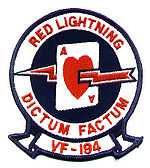VF-194
| Fighter Squadron 194 | |
|---|---|
 VF-194 insignia | |
| Active | 26 March 1952 - 1 March 1978 |
| Country | United States |
| Branch | United States Navy |
| Type | fighter squadron |
| Nickname | "Red Lightnings" |
Fighter squadron VF-194 Red Lightnings was an aviation unit of the United States Navy. It was established in 1952 and disestablished in 1978. It was reactivated for a short time again between 1986 and 1988.
Squadron lineage
The US Navy does not recognize the tradition of squadrons once they have been disestablished. Therefore, even if there is a squadron with the same designation and nickname, it is officially a totally new squadron.[citation needed] Three different squadrons have been designated VF-194 since 1948.
VF-194 Main Battery (1950-1955)
The first VF-194 was established on 15 July 1948 as VF-153 Thundercats, flying the Grumman F8F-2 Bearcat. On 15 February 1950 the squadron was redesignated VF-194 and changed its nickname to Main Battery. In 1951 this VF-194 transitioned to the Douglas AD-2 Skyraider which it flew through various marks until being equipped with the Grumman A-6 Intruder in 1966. As an attack squadron it was redesignated VA-196 on 4 May 1955. It was finally disestablished on 21 March 1997.
VF-194 Yellow Devils (1955-1958)
On 18 May 1955 a second VF-194 was established, nicknamed the Yellow Devils. It was equipped with the McDonnell F2H-3 Banshee and made a single deployment to the Western Pacific on the aircraft carrier USS Kearsarge (CVA-33) from August 1957 to April 1958 as part of Air Task Group 3 (ATG-3). Only eight days after the end of this deployment VF-194 and ATG-3 were disestablished on 10 April 1958.
VF-194 Red Lightnings (1952-1977 and 1986-1988)
The U.S. Navy fighter squadron VF-194 was established as VF-91 on 26 March 1952 and equipped with the Grumman F9F-2 Panther. The squadron was assigned to Carrier Air Group 9 (CVG-9) and made its first deployment on the USS Philippine Sea (CVA-47) from December 1952 to August 1953 to Korea and the Western Pacific. In 1954 the squadron exchanged their Panthers for the swept wing Grumman F9F-6 Cougar. Between 11 May 1954 and 12 December 1954 VF-91 circumnavigated the world aboard the USS Hornet (CVA-12). From February to June 1956 VF-91 made its next deployment on the USS Oriskany (CVA-34), this time equipped with the F9F-8 Cougar.
The F9F-8s were replaced by the North American FJ-3 Fury in 1957 and the squadron made a Western Pacific cruise aboard the USS Ticonderoga (CVA-14) between September 1957 and April 1958.
In 1959 VF-91 transitioned to the Vought F-8C Crusader and made three deployments aboard the USS Ranger (CVA-61) between 1960 and 1963.
On 1 August 1963 VF-91 was redesignated VF-194 and reassigned to Carrier Air Wing Nineteen. Between 1964 and 1973 VF-194 made eight deployments to the Vietnam War, two aboard the USS Bon Homme Richard (CVA-31) (1964, 1965/66), two aboard the Ticonderoga (1966/67, 1967/68) and the last four aboard the Oriskany. During these deployments the squadron flew the F-8E from 1965 to 1968 and then the F-8J. After the end of the US involvement in Vietnam in 1973, VF-194 made another two cruises to the Western Pacific aboard the Oriskany. VF-194 and its sister squadron VF-191 were the last US Navy fighter squadrons equipped with the F-8 Crusader.
When the Oriskany was retired as the last active Essex-class carrier, VF-194 received the McDonnell Douglas F-4J Phantom in 1976. Together with VF-191 the squadron was reassigned to Carrier Air Wing Fifteen. However, after only one deployment aboard the USS Coral Sea (CV-43) the squadron was disestablished on 1 March 1978.
On 1 December 1986 a new VF-194 was established, which claimed the unit's name and markings. After training with VF-124 the squadron was due to deploy on board the USS Independence (CV-62) flying the Grumman F-14A Tomcat as part of CVW-10. However, VF-194 was disbanded on 30 April 1988, before the cruise could take place.
Gallery
-

An FJ-3 of VF-91 in 1957
-

An F-8C of VF-91 from USS Ranger in 1962
-

F-8Js of VF-194 in 1971
-

An F-4J of VF-194 on USS Coral Sea in 1977
-

F-4Js intercepting a Soviet Tu-95 in 1977
-

An F-14A Tomcat from VF-194 in 1986
-

VF-194 F-14 tail markings
See also
- History of the United States Navy
- List of inactive United States Navy aircraft squadrons
- List of United States Navy aircraft squadrons
